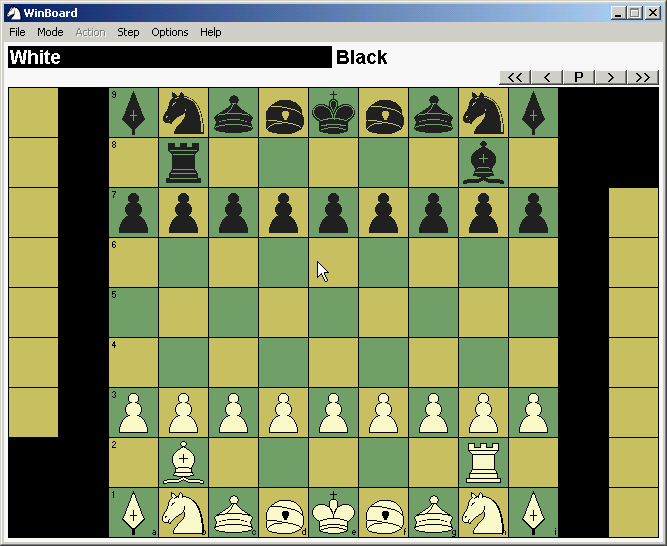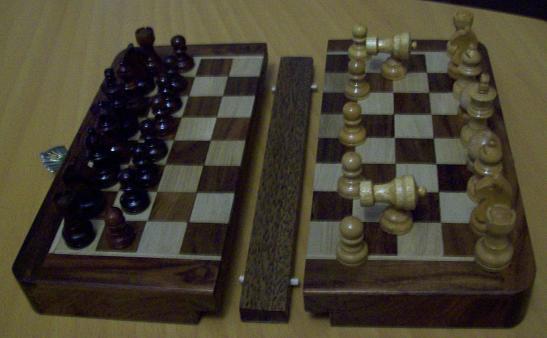Comments/Ratings for a Single Item
 Spike wrote on Mon, Nov 18, 2002 01:32 PM UTC:Good ★★★★
Spike wrote on Mon, Nov 18, 2002 01:32 PM UTC:Good ★★★★ Anonymous wrote on Thu, Dec 19, 2002 05:35 AM UTC:Excellent ★★★★★
Anonymous wrote on Thu, Dec 19, 2002 05:35 AM UTC:Excellent ★★★★★Very Nice... Can anyone point me where I can download XiangQi board software with western pieces (instead of the one with their readitional character pieces). Thanks.
 Richard Brown wrote on Mon, Jun 23, 2003 04:00 PM UTC:Excellent ★★★★★
Richard Brown wrote on Mon, Jun 23, 2003 04:00 PM UTC:Excellent ★★★★★I disagree. Xiangqi should be played over a grid, not squares. That probably explains the Horse and the Elephant move. On squares, it's more natural to jump over an intermediate piece. On a grid, the intermediate piece blocks the way. Then, since there is no long diagonal moves, there is no need in checkering. However, I agree that replacing the XQ piece by figurative pieces (Staunton or other) could be useful for popularizing the game in the West. But this has nothing to do with the board.
Below is my actual rendition of this idea:
For the palace and the river, I'm using vynil strips (cut from a placemat), Seirawan Elephants for the Chinese Elephants, Orthodox Bishops as the Guards, and homemade Cannons.
For the Cannons I used drilled beheaded Rooks (I used the Rook tops to glue on Knights to make Chancellors).
I have several comments: 1. I believe Seirawan and Harper forbid their pieces being used for any other purposes but Seirawan chess. I happened to get into an ugly email correspondence over this. They want their pieces ONLY used for Seirawan chess. I will say that one could put a second queen in there instead of the Bishops, and use the Bishops to replace the elephants, and it should be ok. 2. I personally would rather not have a big X through the forts on the board. But, that would be your choice. I guess if everyone wanted to use it for just Chinese Chess, it might make sense though.
 H. G. Muller wrote on Tue, Aug 19, 2008 11:06 AM UTC:
H. G. Muller wrote on Tue, Aug 19, 2008 11:06 AM UTC:

Checkering the board is not really useful in the absence of Bishops.
So in stead the light / dark square colors are used to contrast the
river banks and palaces. The Mandarins are indicated by a mandarin cap,
which is then used to represent Ferz throughout all variants in WinBoard.
The Elephants and Cannons speak for themselves.
The 'Generals', which we of course tend to think of as Kings, are represented
by the WinBoard Wazir symbol. I am not sure if it would be better to use the
ordinary King symbol here to represent royalty, or use the Wazir to indicate
the moves of the piece. The ornament on the Wazir turban is of course ideal
for indicating royalty. A normal Wazir could use a turban without ornament.
| You know, I don't think it's fair to put words in the mouth of the people who are promoting Seirawan Chess. I mean, if they don't want their pieces used for any other variant, I will understand and respect their wishes. But until I hear from them myself or see that they make a public statement to the effect that they only want their pieces used for any game besides Seirawan chess, I don't think it's fair to state this is what they want. |
You cannot dictate what people use your 'Chess Pieces' for. I wonder if Seirawan would object to me using his Hawk as a paper weight? He'll just have to take me to court over it. Honestly, if he doesn't want people to buy his pieces then that's his problem, but I'm sure as Hell gonna promote them, whether it be my own game or otherwise.
Simon: We don't have any proof that this is what's going on with Seirawan chess. Don't pass judgment until we can get a confirmation from them. I have already sent them an email asking for them to clarify.
Rich, I'll respond to your comments in the opposite order. >> 2. I personally would rather not have a big X through the forts on the board. The X's are actually 4 strips of vynil, and are just laid on top of the board in the shape of the X's, and are not glued or otherwise permanently stuck on the board. >> 1. I believe Seirawan and Harper forbid their pieces being used for any other purposes but Seirawan chess. I'll let the other comments in progress address this. They have hit the mark and are on the right track.
 Anonymous wrote on Thu, Sep 30, 2010 12:39 PM UTC:Good ★★★★
Anonymous wrote on Thu, Sep 30, 2010 12:39 PM UTC:Good ★★★★ H. G. Muller wrote on Mon, Oct 4, 2010 04:34 PM UTC:
H. G. Muller wrote on Mon, Oct 4, 2010 04:34 PM UTC:WinBoard uses the Wazir symbol for Gold, and the Ferz symbol for Silver, as these Generals are basically Wazir and Ferz augmented with all forward moves:

 H. G. Muller wrote on Mon, Oct 4, 2010 05:42 PM UTC:
H. G. Muller wrote on Mon, Oct 4, 2010 05:42 PM UTC:I converted a travel mini Chess set (square size 15.5mm) to become multi-functional set for Xiangqi and international Chess. Because Xiangqi can be played on the grid points, all that is needed is an extra rank to be slipped in between the board halves. Because this is the River, it needs no checkering. And then some extra pieces for the Cannons and Advisors, which I cut from a rond stick, or made from wood beads, respectively.

The River can be inserted on the top face of the set for Xiangqi, or at the bottom for international Chess (to fix the two halves to each other). When the box is closed, it fits in sideways.

I think Xiangqi should be played with traditional Chinese pieces. I bought a wooden set on Ebay. It was very cheap. After a while they are easy to understand because chess thinking is really very abstract. I think one should keep to traditions that are thousands of years old. It adds to the dimension of Chinese chess. However, this set of yours could be used for chess variants. /Mats
 Joe Joyce wrote on Tue, Oct 5, 2010 06:18 PM UTC:
Joe Joyce wrote on Tue, Oct 5, 2010 06:18 PM UTC:In my opinion, for better visualization for western begginers, rather than traditional black-and-white checkering, board need special marking for squares, accesible by elephants. And different marking for advisors. And advisors should not resemble queens (unless if player, being new at Xiang-Qi, is not new at Shatranj). Of course, it is not needed if one already visualize it well. My own prefrence is traditional board.
25 comments displayed
Permalink to the exact comments currently displayed.
